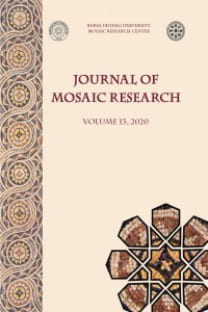Batı Doğu ile Buluşuyor: Ionia’nın Roma Mozaikleri
Ionia, Batı Anadolu, opus tessellatum, Roma mozaikleri
West Meets East: Roman Mosaics of Ionia
Roman Mosaics, Ionia, West Anatolia, opus tessellatum,
___
- B. Andreae, 2003, Antike Bildmosaiken, Mainz am Rhein.
- M. Bachmann, 2011, “Bau Z in Pergamon – Analyse einer “Langfristnutzung”, Ladstätter – Scheibelreiter 2010, 179-191.
- J. Balty, 1981, “La mosaïque antique au Proche-Orient I. Des origines à la Tétrarchie”, ANRW II 12.2, 347-429.
- F. Berti, 1983, “I mosaici di Iasos”, CMGR III, 235-246.
- O. Bingöl, 1997, Malerei und Mosaik der Antike in der Türkei, Mainz am Rhein.
- P. Bruneau, 1972, Les mosaïques, Delos 29, Paris.
- P. Bruneau, 1981, “Tendances de la mosaïque en Grèce à l’époque impériale”, ANRW II 12.2, 320-346.
- CMGR III R. Farioli Campanati (Hrsg.), III colloquio internazionale sul mosaico antico Ravenna 1980, Ravenna 1983.
- CMGR V P. Johnson – R. Ling – D. J. Smith (Eds.), Fifth International Colloquium on Ancient Mosaics held in Bath, England on September 5-12, 1987, I. II (Ann Arbor, MI 1994/1995).
- W. A. Daszewski, 1985, Corpus of Mosaics from Egypt I. Hellenistic and Early Roman Period. Aegyptiaca Treverensia, Trierer Studien zum Griechisch-Römischen Ägypten Band 3, Mainz am Rhein.
- Décor I C. Balmelle – M. Blanchard Lemée – J. Christophe.-J. P. Darmon – A. M. Guimier Sorbets – H. Lavagne – R. Prudhomme – H. Stern, Le Décor Géométrique De La Mosaïque Romaine I, Picard Editeur, Paris, 1985.
- Décor II C. Balmelle – M. Blanchard Lemée – J. P. Darmon – S. Gozlan – M. P. Raynaud, Le Décor Géométrique De La Mosaïque Romaine II, Picard Editeur, Paris, 2002.
- M. Donderer, 1986, Die Chronologie der römischen Mosaiken in Venetien und Istrien bis zur Zeit der Antonine, AF 15, Berlin.
- M. Donderer, 1987, Die antiken Pavimenttypen und ihre Benennungen (Zu Plinius, Naturalis Historia 36, 184-189), JdI 102, 365-377.
- M. Donderer, 1989, Die Mosaizisten der Antike und ihre wirtschaftliche und soziale Stellung. Eine Quellenstudie, Erlanger Forschungen Reihe A – Geisteswissenschaften Band 48, Erlangen.
- M. Donderer, 2008, Die Mosaizisten der Antike II. Epigraphische Quellen – Neufunde und Nachträge, Erlanger Forschungen Reihe A – Geisteswissenschaften Band 116, Erlangen.
- K. M. D. Dunbabin, 1979, Technique and Materials of Hellenistic Mosaics, AJA 83, 265-277.
- K. M. D. Dunbabin, 1999, Mosaics oft he Greek and Roman World, Cambridge.
- G. Hellenkemper-Salies, 1986, Römische Mosaiken in Griechenland, BJb 186, 241-284.
- W. Hoepfner, 2011, Ionien – Brücke zum Orient, Darmstadt.
- W. Hoepfner – E. L. Schwandner, 1994, Haus und Stadt im klassischen Griechenland, Wohnen in der klassischen Polis Band I2, München Berlin.
- W. Jobst, 1977, Römische Mosaiken aus Ephesos I. Die Hanghäuser des Embolos, Mit einem Beitrag von H. Vetters, FiE VIII/2, Wien.
- W. Jobst, 1999, Antike Tessellatpavimente in Ephesos, H. Friesinger – F. Krinzinger (Hrsgg.), 100 Jahre Österreichische Forschungen in Ephesos. Akten des Symposions Wien 1995, Österreichische Akademie der Wissenschaften, Philosophisch-Historische Klasse Denkschriften 260. Band, Wien, 569-578.
- W. Jobst, 2014, OPUS MUSIVUM – “Bunte Steine. Die Technik der antiken Mosaikkunst”, M. Novotná et al. (Eds.), Proceedings of the International Conference “Arts and Crafts over the passage of time”, Pezinok 19-21 October 2012, Anodos, 11/2011, 159-169.
- A. Kankeleit, 1994, Die kaiserzeitlichen Mosaiken in Griechenland I. II, Diss. Rheinische Friedrich-Wilhelms-Universität Bonn.
- S. Ladstätter – V. Scheibelreiter (Hrsgg.), 2010, Städtisches Wohnen im östlichen Mittelmeerraum 4. Jh. V. Chr. – 1. Jh. N. Chr. Akten des Internationalen Kolloquiums vom 24.-27. Oktober an der Österreichischen Aklademie der Wissenschaften, Denkschriften der Philosphisch-Historischen Klasse 397. Band, Wien.
- D. Levi, 1947, Antioch Mosaic Pavements, Princeton, NJ.
- C. Marek, 2010, Geschichte Kleinasiens in der Antike. Unter Mitarbeit von Peter Frei, München.
- M. L. Morricone Matini, 1971, I pavimenti di signino repubblicani di Roma e dintorni, Roma.
- Ovadiah 1994/1995 A. Ovadiah, Mosaic pavements oft he Herodian Period in Israel, CMGR V, 67-76.
- D. Salzmann, 1982, Untersuchungen zu den antiken Kieselmosaiken von den Anfängen bis zum Beginn der Tesseratechnik, AF 10, Berlin.
- D. Salzmann, 2011, “Hellenistische und frühkaiserzeitliche Mosaiken und Pavimente in Pergamon”, R. Grüßinger – V. Kästner – A. Scholl (Hrsgg.), Pergamon. Panorama der antiken Metropole. Begleitbuch zur Ausstellung, Berlin, 101-107, 518-521.
- V. Scheibelreiter, 2005, “Ein schwarzfiguriges Mosaik aus dem Vediusgymnasium von Ephesos”, Römische Historische Mitteilungen 47, 55-79.
- V. Scheibelreiter, 2007, Römische Mosaiken in Westkleinasien, M. Meyer (Hrsg.), Neue Zeiten – Neue Sitten. Zu Rezeption und Integration römischen und italischen Kulturguts in Kleinasien, Wiener Forschungen zur Archäologie Band 12, Wien.
- V. Scheibelreiter-Gail, 2011, Die Mosaiken Westkleinasiens. Tessellate des 2. Jahrhunderts v. Chr. bis Anfang des 7. Jahrhunderts n. Chr. Sonderschriften des Österreichischen Archäologischen Instituts Band 46, Wien.
- Thür – Rathmayr H. Thür – E. Rathmayr (Hrsgg.), Hanghaus 2 in Ephesos. Die Wohneinheit 6. Baubefund, Ausstattung, Funde, FiE VIII/9, Wien.
- ISSN: 1309-047X
- Başlangıç: 2008
- Yayıncı: Ululdağ Üniversitesi, Mozaik Araştırlmaları Merkezi
Roma Mozaiklerinin İkonografisinde Doğu Batı’ya Karşı: Ortak Konulardan Seçilmiş Örnekler
Abelterium: Casa da Medusa Villası ve Quinta do Pião’nun Geometrik Mozaikleri
Hispanik Meseta Norte’ninMozaikleri: Evreler, Atölyeler, Sanatsal Yönü
Fernando REGUERAS, Caridad SAN JOSÉ
Roma: İÖ 2. yüzyıl’da Ekonomik Değişim - Lüks Bir Ürün Olarak Mozaik Konteksti
Bracara Augusta’nın Roma Mozaikleri: Dekoratif Motiflerin Yeniden Okunması ve Yeniden Yorumlanması
Fátima ABRAÇOS, Licínia WRENCH
Portekiz’de Yer Alan São Simão Roma Villası’ndan Mozaikler
Sónia VICENTE VICENTE, Ana Luísa MENDES
Armazéns Sommer’de (Lizbon) Açığa Çıkarılan Roma Mozaiği. Arkeoloji ve İkonografi
Ricardo Ávila RIBEIRO, Vasco Noronha VIEIRA, Paulo REBELO, Nuno NETO
